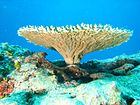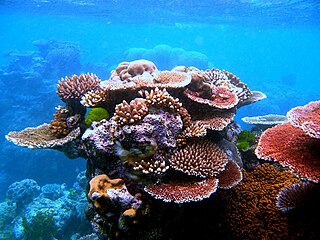
Corals are colonial marine invertebrates within the class Anthozoa of the phylum Cnidaria. They typically form compact colonies of many identical individual polyps. Coral species include the important reef builders that inhabit tropical oceans and secrete calcium carbonate to form a hard skeleton.
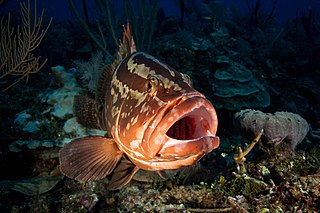
The Nassau grouper is one of the large number of perciform fishes in the family Serranidae commonly referred to as groupers. It is the most important of the groupers for commercial fishery in the West Indies, but has been endangered by overfishing.

Acropora is a genus of small polyp stony coral in the phylum Cnidaria. Some of its species are known as table coral, elkhorn coral, and staghorn coral. Over 149 species are described. Acropora species are some of the major reef corals responsible for building the immense calcium carbonate substructure that supports the thin living skin of a reef.

White band disease is a coral disease that affects acroporid corals and is distinguishable by the white band of exposed coral skeleton that it forms. The disease completely destroys the coral tissue of Caribbean acroporid corals, specifically elkhorn coral and staghorn coral. The disease exhibits a pronounced division between the remaining coral tissue and the exposed coral skeleton. These symptoms are similar to white plague, except that white band disease is only found on acroporid corals, and white plague has not been found on any acroporid corals. It is part of a class of similar disease known as "white syndromes", many of which may be linked to species of Vibrio bacteria. While the pathogen for this disease has not been identified, Vibrio carchariae may be one of its factors. The degradation of coral tissue usually begins at the base of the coral, working its way up to the branch tips, but it can begin in the middle of a branch.

The green humphead parrotfish is the largest species of parrotfish, growing to lengths of 1.5 m (4.9 ft) and weighing up to 75 kg (165 lb).

The staghorn coral is a branching, stony coral with cylindrical branches ranging from a few centimetres to over two metres in length and height. It occurs in back reef and fore reef environments from 0 to 30 m depth. The upper limit is defined by wave forces, and the lower limit is controlled by suspended sediments and light availability. Fore reef zones at intermediate depths 5–25 m (16–82 ft) were formerly dominated by extensive single-species stands of staghorn coral until the mid-1980s. This coral exhibits the fastest growth of all known western Atlantic fringe corals, with branches increasing in length by 10–20 cm (3.9–7.9 in) per year. This has been one of the three most important Caribbean corals in terms of its contribution to reef growth and fishery habitat.
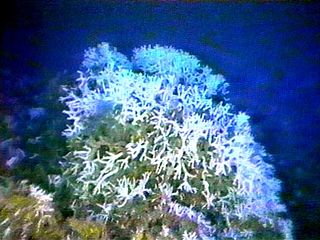
Oculina varicosa, or the ivory bush coral, is a scleractinian deep-water coral primarily found at depths of 70-100m, and ranges from Bermuda and Cape Hatteras to the Gulf of Mexico and the Caribbean. Oculina varicosa flourishes at the Oculina Bank off the east coast of Florida, where coral thickets house a variety of marine organisms. The U.S. National Marine Fisheries Service considers Oculina a genus of concern, due to the threat of rapid ocean warming. Species of concern are those species about which the U.S. Government's National Oceanic and Atmospheric Administration (NOAA), National Marine Fisheries Service, has some concerns regarding status and threats, but for which insufficient information is available to indicate a need to list the species under the U.S. Endangered Species Act (ESA). While Oculina is considered a more robust genus in comparison to tropical corals, rising ocean temperatures continue to threaten coral health across the planet.

The Florida Reef is the only living coral barrier reef in the continental United States. It lies a few miles seaward of the Florida Keys, is about 4 miles wide and extends 270 km (170 mi) from Fowey Rocks just east of Soldier Key to just south of the Marquesas Keys. The barrier reef tract forms a great arc, concentric with the Florida Keys, with the northern end, in Biscayne National Park, oriented north-south and the western end, south of the Marquesas Keys, oriented east-west. The rest of the reef outside Biscayne National Park lies within John Pennekamp Coral Reef State Park and the Florida Keys National Marine Sanctuary. Isolated coral patch reefs occur northward from Biscayne National Park as far north as Stuart, in Martin County. Coral reefs are also found in Dry Tortugas National Park west of the Marquesas Keys. There are more than 6,000 individual reefs in the system. The reefs are 5,000 to 7,000 years old, having developed since sea levels rose following the Wisconsinan glaciation.

White pox disease, first noted in 1996 on coral reefs near the Florida keys, is a coral disease affecting Elkhorn coral throughout the Caribbean. It causes irregular white patches or blotches on the coral that result from the loss of coral tissue. These patches distinguish white pox disease from white band disease which produces a distinctive white band where the coral skeleton has been denuded. The blotches caused by this disease are also clearly differentiated from coral bleaching and scars caused by coral-eating snails. It is very contagious, spreading to nearby coral.

Looe Key is a coral reef located within the Florida Keys National Marine Sanctuary. It lies to the south of Big Pine Key. This reef is within a Sanctuary Preservation Area (SPA). Part of Looe Key is designated as "Research Only," an area which protects some of the patch reefs landward of the main reef.
Essential Fish Habitat (EFH) was defined by the U.S. Congress in the 1996 amendments to the Magnuson-Stevens Fishery Conservation and Management Act, or Magnuson-Stevens Act, as "those waters and substrate necessary to fish for spawning, breeding, feeding or growth to maturity." Implementing regulations clarified that waters include all aquatic areas and their physical, chemical, and biological properties; substrate includes the associated biological communities that make these areas suitable for fish habitats, and the description and identification of EFH should include habitats used at any time during the species' life cycle. EFH includes all types of aquatic habitat, such as wetlands, coral reefs, sand, seagrasses, and rivers.

Acropora prolifera, the fused staghorn coral, is a branching, colonial, stony coral found in shallow parts of the Caribbean Sea, the Bahamas and southern Florida.

Acropora pulchra is a species of colonial staghorn coral in the family Acroporidae. It is found on the back fringes of reefs in shallow water in the western Indo-Pacific Ocean. The oldest fossils of this species date back to the Pleistocene.

Acropora aspera is a species of staghorn coral in the family Acroporidae. It is found on reef flats and in lagoons in very shallow water in the western Indo-Pacific Ocean.

Acropora microphthalma is a species of acroporid coral found in the Red Sea, the Gulf of Aden, the southwest and northern Indian Ocean, the central Indo-Pacific, Australia, Southeast Asia, Japan, the East China Sea and the oceanic west and central Pacific Ocean. It is also found in the Line Islands. It occurs in shallow tropical reefs on upper reef slopes, in turbid water and in sandy lagoons. It can be found from depths of 5–25 m.
The St. Croix East End Marine Park (STXEEMP) was established to "protect territorially significant marine resources, and promote sustainability of marine ecosystems, including coral reefs, sea grass beds, wildlife habitats and other resources, and to conserve and preserve significant natural areas for the use and benefit of future generations." It is the U.S. Virgin Islands’ first territorially designated and managed marine protected area (MPA).
Acropora rudis is a species of acroporid coral found in the Indo-Pacific region. It is an uncommon species and is classified by the International Union for Conservation of Nature as an endangered species because it is particularly susceptible to coral bleaching, coral diseases, damage by the crown-of-thorns starfish and destruction of its coral reef habitat.

Stony coral tissue loss disease (SCTLD) is a disease of corals that first appeared off the southeast coast of Florida in 2014. It originally was described as white plague disease. By 2019 it had spread along the Florida Keys and had appeared elsewhere in the Caribbean Sea. The disease destroys the soft tissue of at least 22 species of reef-building corals, killing them within weeks or months of becoming infected. The causal agent is unknown but is suspected to be either a bacterium or a virus with a bacterium playing a secondary role. The degree of susceptibility of a coral, the symptoms, and the rate of progression of the disease vary between species. Due to its rapid spread, high mortality rate, and lack of subsidence, it has been regarded as the deadliest coral disease ever recorded, with wide-ranging implications for the biodiversity of Caribbean coral reefs.

Coral reef restoration strategies use natural and anthropogenic processes to restore damaged coral reefs. Reefs suffer damage from a number of natural and man-made causes, and efforts are being made to rectify the damage and restore the reefs. This involves the fragmentation of mature corals, the placing of the living fragments on lines or frames, the nurturing of the fragments as they recover and grow, and the transplantation of the pieces into their final positions on the reef when they are large enough.
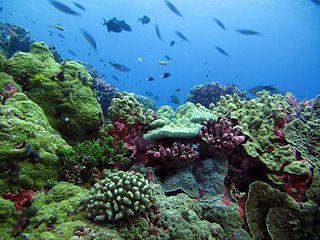
The Coral reefs of Kiribati consists of 32 atolls and one raised coral island, Banaba, which is an isolated island between Nauru and the Gilbert Islands. The islands of Kiribati are dispersed over 3.5 million km2 (1.4 million sq mi) of the Pacific Ocean and straddle the equator and the 180th meridian, extending into the eastern and western hemispheres, as well as the northern and southern hemispheres. 21 of the 33 islands are inhabited. The groups of islands of Kiribati are:

























